-
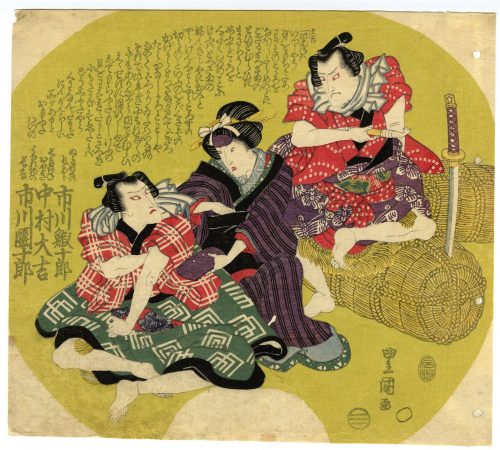 Artist: Utagawa Toyokuni I [歌川豊国] (1769–1825). Publisher: Ibaya Senzaburō [伊場屋 仙三郎] (fl. 1815 – 1869). Signed: Toyokuni ga [豊国 画]. Publisher's seal: Ibaya Sensaburō (Marks 08-067 | 127b). Date-aratame seal: Bunsei 3 (1820). Size: Uncut fan print (uchiwa-e), 224 x 254 mm. Ichikawa Ebijūrō I as Nuregami Chōgorō [濡髪の長五郎], Nakamura Daikichi as Hanaregoma Oseki [放駒のお関], and Ichikawa Danjūrō VII as Hanaregoma Chōkichi [放駒長吉] in a kabuki play Futatsu Chôchô Kuruwa Nikki [双蝶々曲輪日記] (A Diary of Two Butterflies in the Pleasure Quarters (see: LIB-0879.2015 | Brandon, James R., Leiter, Samuel L. Kabuki Plays on Stage: Brilliance and Bravado, 1697-1766 (Volume 1). — Honolulu: University of Hawai'i Press, 2002.) The play was performed at Kawarasakiza (Edo) in May of 1820. Actors: Ichikawa Ebijūrō I [市川鰕十郎] (Japanese, 1777 – 1827); other names: Ichikawa Ichizō I [市川市蔵], Ichinokawa Ichizō [市ノ川市蔵]. Nakamura Daikichi I [初代中村大吉](Japanese, 1773 – 1823); other names: Fujikawa Daikichi [藤川大吉]; poetry name Hajō [巴丈]; pen name Naruo Yatarō [藤川大吉]. Ichikawa Danjūrō VII 市川団十郎 (Japanese, 1791 – 1859); other names: Ichikawa Ebizō V, Ichikawa Hakuen II, Ichikawa Shinnosuke I.
Artist: Utagawa Toyokuni I [歌川豊国] (1769–1825). Publisher: Ibaya Senzaburō [伊場屋 仙三郎] (fl. 1815 – 1869). Signed: Toyokuni ga [豊国 画]. Publisher's seal: Ibaya Sensaburō (Marks 08-067 | 127b). Date-aratame seal: Bunsei 3 (1820). Size: Uncut fan print (uchiwa-e), 224 x 254 mm. Ichikawa Ebijūrō I as Nuregami Chōgorō [濡髪の長五郎], Nakamura Daikichi as Hanaregoma Oseki [放駒のお関], and Ichikawa Danjūrō VII as Hanaregoma Chōkichi [放駒長吉] in a kabuki play Futatsu Chôchô Kuruwa Nikki [双蝶々曲輪日記] (A Diary of Two Butterflies in the Pleasure Quarters (see: LIB-0879.2015 | Brandon, James R., Leiter, Samuel L. Kabuki Plays on Stage: Brilliance and Bravado, 1697-1766 (Volume 1). — Honolulu: University of Hawai'i Press, 2002.) The play was performed at Kawarasakiza (Edo) in May of 1820. Actors: Ichikawa Ebijūrō I [市川鰕十郎] (Japanese, 1777 – 1827); other names: Ichikawa Ichizō I [市川市蔵], Ichinokawa Ichizō [市ノ川市蔵]. Nakamura Daikichi I [初代中村大吉](Japanese, 1773 – 1823); other names: Fujikawa Daikichi [藤川大吉]; poetry name Hajō [巴丈]; pen name Naruo Yatarō [藤川大吉]. Ichikawa Danjūrō VII 市川団十郎 (Japanese, 1791 – 1859); other names: Ichikawa Ebizō V, Ichikawa Hakuen II, Ichikawa Shinnosuke I. -
 Artist: Utagawa Kuniyoshi [歌川 國芳] (Japanese, 1798 – 1861).
Artist: Utagawa Kuniyoshi [歌川 國芳] (Japanese, 1798 – 1861).Title: Suzume fukube [美人団扇絵] (Sparrow and gourds).
Series: Kacho awase [花鳥合] (Collection of flowers and birds).
Publisher: Aritaya Seiemon [有田屋 清右衛門] (Japanese, fl. c. 1830 – 1862); Seal: Marks 17-011 | 014d.Signed: Ichiyosai Kuniyoshi ga in a red cartouche and sealed with paulownia crest (kiri mon).
Size: Uchiwa-e (untrimmed fan print) 296 x 230 mm.
Double nanushi censor seals: Kinugasa & Watanabe, Kaei 2-3 (1849–50).
Ref.: Kuniyoshi Project. -
 Ogata Gekkō [尾形月耕] (Japanese, 1859 – 1920). An uchiwa-e (fan-print) of advertisement of tobacco of Kagoshima Prefecture, c. 1890 (Meiji Period). Barefoot Tengu* is sitting on a torii (entrance to a Shinto shrine), smoking a cigarette through a mouthpiece. _______ * Tengu [天狗] (heavenly dog) is a type of legendary creature found in Japanese folk religion and are also considered a type of Shinto god (kami) or yōkai (supernatural beings).
Ogata Gekkō [尾形月耕] (Japanese, 1859 – 1920). An uchiwa-e (fan-print) of advertisement of tobacco of Kagoshima Prefecture, c. 1890 (Meiji Period). Barefoot Tengu* is sitting on a torii (entrance to a Shinto shrine), smoking a cigarette through a mouthpiece. _______ * Tengu [天狗] (heavenly dog) is a type of legendary creature found in Japanese folk religion and are also considered a type of Shinto god (kami) or yōkai (supernatural beings). -
 Artist: Utagawa Sadahide [歌川 貞秀], a.k.a. Gountei Sadahide [五雲亭 貞秀] (1807 – c. 1878/9). Publisher: Iseya Ichiemon [伊勢屋市右衛門] (Japanese, fl. c 1823 – 1864), seal name Kaku-Tsuji [角辻]. Signed: Gountei Sadahide ga [五雲亭貞秀画] Censor's seal: kiwame, date seal: Tenpō 3 (1832). Size: Uncut fan print (uchiwa-e); 218 x 282 mm. Portrait of a young woman dressed in a green kimono decorated with arabesque (karakusa) and flowers, her black obi adorned with a dragon, in a western-style frame, on a blue background; and a painting of a parrot on a pomegranate tree. A similar design was used by Sadahide in 1860, described in detail by Sebastian Izzard in his Japanese Prints of the Mid-Nineteenth Century: 1830–1865, September 20–October 24, 2006 exhibition: Picture of a Curio Shop in Yokohama: reverse painting on glass of a crimson parrot, coloured copperplate engraving of a mother and child (Yokohama urimono mise no zu: gyokuban abura-e, doban-e saishiki). Colour woodblock print: oban tate-e, 143/8 x 93/4 in. (36.5 x 24.8 cm.); Man-en I/3 (3/1860) Series: Picture of Goods for Sale in Yokohama (Yokohama urimono zue no uchi) Signature: Gountei Sadahide ga, double toshidama seal Publisher: Daikokuya Kinnosuke.
Artist: Utagawa Sadahide [歌川 貞秀], a.k.a. Gountei Sadahide [五雲亭 貞秀] (1807 – c. 1878/9). Publisher: Iseya Ichiemon [伊勢屋市右衛門] (Japanese, fl. c 1823 – 1864), seal name Kaku-Tsuji [角辻]. Signed: Gountei Sadahide ga [五雲亭貞秀画] Censor's seal: kiwame, date seal: Tenpō 3 (1832). Size: Uncut fan print (uchiwa-e); 218 x 282 mm. Portrait of a young woman dressed in a green kimono decorated with arabesque (karakusa) and flowers, her black obi adorned with a dragon, in a western-style frame, on a blue background; and a painting of a parrot on a pomegranate tree. A similar design was used by Sadahide in 1860, described in detail by Sebastian Izzard in his Japanese Prints of the Mid-Nineteenth Century: 1830–1865, September 20–October 24, 2006 exhibition: Picture of a Curio Shop in Yokohama: reverse painting on glass of a crimson parrot, coloured copperplate engraving of a mother and child (Yokohama urimono mise no zu: gyokuban abura-e, doban-e saishiki). Colour woodblock print: oban tate-e, 143/8 x 93/4 in. (36.5 x 24.8 cm.); Man-en I/3 (3/1860) Series: Picture of Goods for Sale in Yokohama (Yokohama urimono zue no uchi) Signature: Gountei Sadahide ga, double toshidama seal Publisher: Daikokuya Kinnosuke.
-
 Artist (attributed, no signature): Suzuki Harunobu [鈴木 春信] (Japanese, c. 1725 – 1770). The title is taken from [LIB-1478.2013] Gian Carlo Calza, Stefania Piotti. Poem of the pillow and other stories. — Phaidon Press, 2010; pp. 148-9. Alternative title: Man sucking woman's breast and a cat sitting under a bonsai tree. The open book beside the couple reads 子春 (Koharu). Woodblock print from the series Mirror Picture of Japan (Wakoku kagami); Size: Horizontal chuban; 21 x 26 cm.
Artist (attributed, no signature): Suzuki Harunobu [鈴木 春信] (Japanese, c. 1725 – 1770). The title is taken from [LIB-1478.2013] Gian Carlo Calza, Stefania Piotti. Poem of the pillow and other stories. — Phaidon Press, 2010; pp. 148-9. Alternative title: Man sucking woman's breast and a cat sitting under a bonsai tree. The open book beside the couple reads 子春 (Koharu). Woodblock print from the series Mirror Picture of Japan (Wakoku kagami); Size: Horizontal chuban; 21 x 26 cm. -
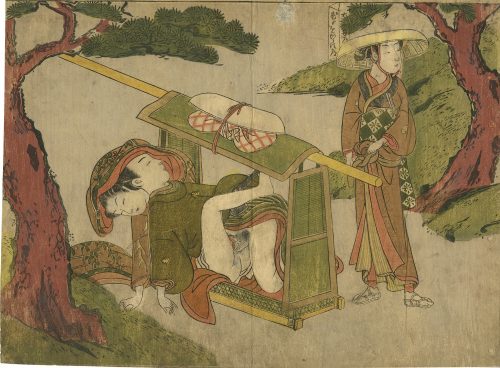 A shunga (erotic) print by Suzuki Harunobu [鈴木 春信] (Japanese, c. 1725 – 1770) depicting a woman making love with a man in the palanquin (のりもの/乗り物) while the other woman "ties a sash about her hips below her obi." The sheet is not signed; however, it is attributed to Harunobu. A reference image can be found in the Metropolitan Museum (NY) collection, Accession Number JP1635:According to the MET "the palanquin ... has carried these courtesans to the shore for a spring outing". Some time ago, a similar print was sold by Richard Kruml (description: A chuban shunga print showing the occupant of a kago in flagrante with one of the porters, having seized the opportunity of a stop on the journey. Published late 1760s. Rare). Another copy was sold at Sotheby's in Paris for €3,360 on November 27, 2002 (Lot 24), with a reproduction of the print's detail and description on p. 39: Suzuki Harunobu (1725 – 1770) | Shunga: couple dans un palanquin, vers 1768-1770, non-signe, cachet non identifé, cachets Charles Mitchell, Huguette Berès, Format chuban, 20.1 x 28.6 cm | 3000 – 4000 € | Il s’agit probablement de trois voyageurs, l’un d’entre eux debout près du palanquin faisant mine d’ignorer la scène. Bibliographie: Delay p. 87. Reference: [LIB-3121.2022] Sotheby's: Collection Huguette Berès – Estampes, dessins et livres illustrés japonais / 2 volumes; vol. 1. — Paris: Sotheby's, 2002.
A shunga (erotic) print by Suzuki Harunobu [鈴木 春信] (Japanese, c. 1725 – 1770) depicting a woman making love with a man in the palanquin (のりもの/乗り物) while the other woman "ties a sash about her hips below her obi." The sheet is not signed; however, it is attributed to Harunobu. A reference image can be found in the Metropolitan Museum (NY) collection, Accession Number JP1635:According to the MET "the palanquin ... has carried these courtesans to the shore for a spring outing". Some time ago, a similar print was sold by Richard Kruml (description: A chuban shunga print showing the occupant of a kago in flagrante with one of the porters, having seized the opportunity of a stop on the journey. Published late 1760s. Rare). Another copy was sold at Sotheby's in Paris for €3,360 on November 27, 2002 (Lot 24), with a reproduction of the print's detail and description on p. 39: Suzuki Harunobu (1725 – 1770) | Shunga: couple dans un palanquin, vers 1768-1770, non-signe, cachet non identifé, cachets Charles Mitchell, Huguette Berès, Format chuban, 20.1 x 28.6 cm | 3000 – 4000 € | Il s’agit probablement de trois voyageurs, l’un d’entre eux debout près du palanquin faisant mine d’ignorer la scène. Bibliographie: Delay p. 87. Reference: [LIB-3121.2022] Sotheby's: Collection Huguette Berès – Estampes, dessins et livres illustrés japonais / 2 volumes; vol. 1. — Paris: Sotheby's, 2002.
http://www.metmuseum.org/art/collection/search/45071
-
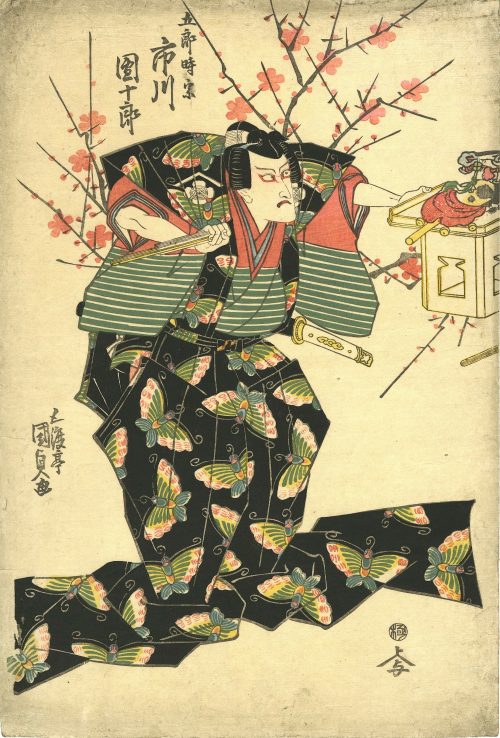 Actor Ichikawa Danjuro VII as Soga Goro Tokimune (one of the Soga brothers). Ichikawa Ebizô V held the name of Ichikawa Danjûrô VII from the 11th lunar month of 1800 to the 2nd lunar month of 1832. Artist: Utagawa Kunisada (Toyokuni III) [歌川 国貞] (Japanese, 1786 – 1865) Publisher: Uemura Yohei (Japanese, 1750 – 1832). Date: 1830 Size: Vertical ōban Signatures/Marks: Gototei Kunisada ga. Publisher's seal: Uemura Yohei. Censor's seal: Kiwame
Actor Ichikawa Danjuro VII as Soga Goro Tokimune (one of the Soga brothers). Ichikawa Ebizô V held the name of Ichikawa Danjûrô VII from the 11th lunar month of 1800 to the 2nd lunar month of 1832. Artist: Utagawa Kunisada (Toyokuni III) [歌川 国貞] (Japanese, 1786 – 1865) Publisher: Uemura Yohei (Japanese, 1750 – 1832). Date: 1830 Size: Vertical ōban Signatures/Marks: Gototei Kunisada ga. Publisher's seal: Uemura Yohei. Censor's seal: Kiwame -
 Artist: Horst Graebner positively attributes the drawing to Utagawa Kunisada II [歌川国貞] Japanese, 1823 – 1880) a.k.a. Toyokuni IV, though Israel Goldman attributes it to Utagawa Kunisada [歌川 国貞] (Japanese, 1786 – 1865) a.k.a. Utagawa Toyokuni III. Title: Geisha with a watch / Preparatory drawing for a fan print. Media/Technique: Ink and colour on paper. Signed: Toyokuni hitsu [豊国筆].
Artist: Horst Graebner positively attributes the drawing to Utagawa Kunisada II [歌川国貞] Japanese, 1823 – 1880) a.k.a. Toyokuni IV, though Israel Goldman attributes it to Utagawa Kunisada [歌川 国貞] (Japanese, 1786 – 1865) a.k.a. Utagawa Toyokuni III. Title: Geisha with a watch / Preparatory drawing for a fan print. Media/Technique: Ink and colour on paper. Signed: Toyokuni hitsu [豊国筆]. -
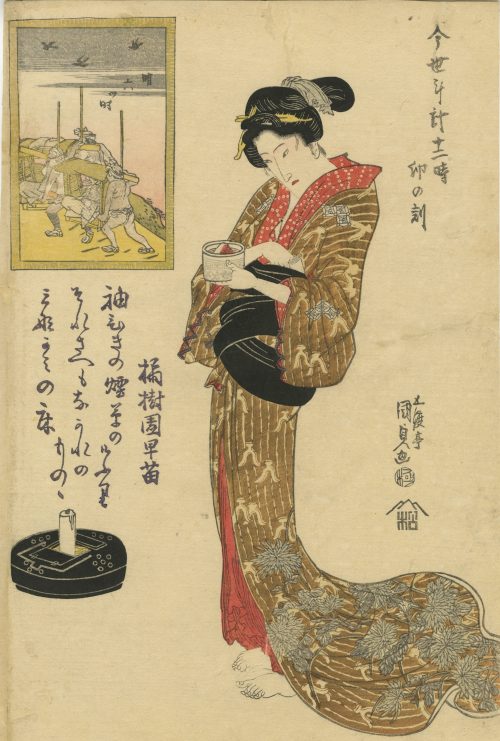 Artist: Utagawa Kunisada [歌川 国貞] a.k.a. Utagawa Toyokuni III [三代歌川豊国] (Japanese, 1786 – 1865). Publisher: Matsumura Tatsuemon [松村辰右衛門] (Japanese, fl. c. 1793 – 1832). Year: c. 1820–22 (Bunsei era). Signed: 五渡亭国貞画 – Gototei Kunisada ga. Censor's seal: kiwame 改印:極
Artist: Utagawa Kunisada [歌川 国貞] a.k.a. Utagawa Toyokuni III [三代歌川豊国] (Japanese, 1786 – 1865). Publisher: Matsumura Tatsuemon [松村辰右衛門] (Japanese, fl. c. 1793 – 1832). Year: c. 1820–22 (Bunsei era). Signed: 五渡亭国貞画 – Gototei Kunisada ga. Censor's seal: kiwame 改印:極

SVJP-0179-6.2014
The Hour of the Dragon, Fifth Hour of Day (Tatsu no koku, Hi no itsutsu toki), from the series Twelve Hours of a Modern Clock (Imayo tokei jūniji) 「今世時計十二時 辰ノ刻 日ノ五つ時」 MFA impression: 11.15315. 
SVJP-0179-1.2014
The Hour of the Rabbit, Sixth Hour of Day (U no koku, Ake muttsu toki), from the series Twelve Hours of a Modern Clock (Imayo tokei jūniji) 「今世時計十二時 卯ノ刻 明六つ時」. MFA impression: 11.15317 
SVJP-0179-2.2014
The Hour of the Monkey, Seventh Hour of Day (Saru no koku, Hi no nanatsu toki), from the series Twelve Hours of a Modern Clock (Imayo tokei jūniji) 「今様時計十二時 申ノ刻 日ノ七つ時」 MFA impression: 11.39692 
SVJP-0179-8.2014
The Hour of the Horse, Ninth Hour of Day (Uma no koku, Hi kokonotsu toki), from the series Twelve Hours of a Modern Clock (Imayo tokei jūniji) 「今世時計十二時 午ノ刻 日九つ時」. MFA impression: 11.15314 
SVJP-0179-4.2014
The Hour of the Boar, Fourth Hour of Night (I no koku, Yoru yottsu toki), from the series Twelve Hours of a Modern Clock (Imayo tokei jūniji) 「今世時計十二時 亥ノ刻 夜四つ時」. MFA impression: 11.15552 
SVJP-0179-3.2014
The Hour of the Tiger, Seventh Hour of Night (Tora no koku, Yoru nanatsu), from the series Twelve Hours of a Modern Clock (Imayo tokei jūniji) 「今世時計十二時 寅ノ刻 夜七つ」. MFA impression: 11.15313 Ref.: Izzard. Kunisada’s world [LIB-2970.2022]. 
SVJP-0179-5.2014
The Hour of the Ox, Eight Hour of Night (Ushi no koku, Yoru no yattsu toki), from the series Twelve Hours of a Modern Clock (Imayo tokei jūniji) 「今世時計十二時 丑ノ刻 夜ノ八つ時」. MFA impression: 11.26906 
SVJP-0179-7.2014
The Hour of the Rat, Ninth Hour of Night (Ne no koku, Yoru kokonotsu toki), from the series Twelve Hours of a Modern Clock (Imayo tokei jūniji) 「今世時計十二時 子ノ刻 夜九つ時」. MFA impression: 11.15312 -
 Title: Lyon Collection: Genji, Chapter 21, the maiden (otome - 乙女): the nine-tailed fox woman (kayō-fujin [花陽夫人]) terrorizing Prince Hanzoku (足王) and his servant from the series Japanese and Chinese parallels to Genji (wakan nazorae genji - 和漢准源氏). British Museum: Otome 乙女 (Maiden) / Waken nazorae Genji 和漢准源氏 (Japanese and Chinese Comparisons for the Chapters of the Genji). Schaap: Prince Hanzoku terrorized by a nine-tailed fox; Series: Wakan nazorae Genji (Japanese and Chinese parallels to Genji) Artist: Utagawa Kuniyoshi [歌川 國芳] (1798 – 1861). Publisher: Iseyoshi [伊勢芳] (Marks 25-013 | U095); seal [イせ芳]. Block carver: Hori Shōji [彫庄治] (Lyon Collection; BM); Hori Takichi [彫多吉] (Schaap). Date-aratame seal: Ansei 2, 7th month (1855). Ref: Jack Hillier. Japanese prints and drawings from the Vever Collection (3 volumes). — New York: Sotheby Parke Bernet & Rizzoli International, 1976; vol.3, p. 868, pl. 847. Robinson (1982): p. 161, S88, № 21. Schaap (1998): p. 115, № 107. SOLD
Title: Lyon Collection: Genji, Chapter 21, the maiden (otome - 乙女): the nine-tailed fox woman (kayō-fujin [花陽夫人]) terrorizing Prince Hanzoku (足王) and his servant from the series Japanese and Chinese parallels to Genji (wakan nazorae genji - 和漢准源氏). British Museum: Otome 乙女 (Maiden) / Waken nazorae Genji 和漢准源氏 (Japanese and Chinese Comparisons for the Chapters of the Genji). Schaap: Prince Hanzoku terrorized by a nine-tailed fox; Series: Wakan nazorae Genji (Japanese and Chinese parallels to Genji) Artist: Utagawa Kuniyoshi [歌川 國芳] (1798 – 1861). Publisher: Iseyoshi [伊勢芳] (Marks 25-013 | U095); seal [イせ芳]. Block carver: Hori Shōji [彫庄治] (Lyon Collection; BM); Hori Takichi [彫多吉] (Schaap). Date-aratame seal: Ansei 2, 7th month (1855). Ref: Jack Hillier. Japanese prints and drawings from the Vever Collection (3 volumes). — New York: Sotheby Parke Bernet & Rizzoli International, 1976; vol.3, p. 868, pl. 847. Robinson (1982): p. 161, S88, № 21. Schaap (1998): p. 115, № 107. SOLD -
 Artist: Utagawa Kuniyoshi [歌川 國芳] (Japanese, 1798 – 1861). Publisher: Ibaya Senzaburō [伊場屋仙三郎] (Japanese, c. 1815 – 1869). Published in c. 1845 (no seal). Possibly, from the "Untitled series of beauties reflected in mirrors", see Kunisada Project. However, this print does not have the seal of the censor Tanaka [田中].
Artist: Utagawa Kuniyoshi [歌川 國芳] (Japanese, 1798 – 1861). Publisher: Ibaya Senzaburō [伊場屋仙三郎] (Japanese, c. 1815 – 1869). Published in c. 1845 (no seal). Possibly, from the "Untitled series of beauties reflected in mirrors", see Kunisada Project. However, this print does not have the seal of the censor Tanaka [田中]. -
 Artist: Utagawa Kuniyoshi [歌川 國芳] (Japanese, 1798 – 1861). Publisher: Izuzen (fl. c. 1800s – 1840s) (Marks 06-029|U103b). Signed: Ichiyosai Kuniyoshi ga in a red cartouche and sealed with paulownia crest (kiri mon). Double nanushi censor seals: Fuku & Muramatsu, 1849-51 (Kaei 2 – Kaei 4). Young woman in front of the western-style framed portrait of Soga Tokimune, who is depicted after having his kusazuri ripped off by Asahina Saburō. The series of fan prints A Collection of Pictures in Modern Style [今様額面合] (Imayô gakumen awase) can be found at Kuniyoshi Project. Soga Tokimune, a.k.a. Soga no Gorō [曾我時致] (Japanese, 1174 – 1193), a historical figure and a character of an epic tale Soga Monogatari [曽我物語] (A Tale of Soga Brothers). Asahina Saburō [朝比奈 三朗], a.k.a. Asahina Yoshihide [朝比奈 義秀] is also mentioned in the Soga Monogatari. Kusazuri [草摺] (くさずり) – tassets on a suit of a samurai's armour. Another Kuniyoshi's print with the same characters: Goro Tokimune and Asahina Saburo; Series: The Tale of Soga Brothers; Publisher: Ibaya Senzaburō; Date: 1843-1845; Size: Vertical Ōban: 359 x 245 mm.
Artist: Utagawa Kuniyoshi [歌川 國芳] (Japanese, 1798 – 1861). Publisher: Izuzen (fl. c. 1800s – 1840s) (Marks 06-029|U103b). Signed: Ichiyosai Kuniyoshi ga in a red cartouche and sealed with paulownia crest (kiri mon). Double nanushi censor seals: Fuku & Muramatsu, 1849-51 (Kaei 2 – Kaei 4). Young woman in front of the western-style framed portrait of Soga Tokimune, who is depicted after having his kusazuri ripped off by Asahina Saburō. The series of fan prints A Collection of Pictures in Modern Style [今様額面合] (Imayô gakumen awase) can be found at Kuniyoshi Project. Soga Tokimune, a.k.a. Soga no Gorō [曾我時致] (Japanese, 1174 – 1193), a historical figure and a character of an epic tale Soga Monogatari [曽我物語] (A Tale of Soga Brothers). Asahina Saburō [朝比奈 三朗], a.k.a. Asahina Yoshihide [朝比奈 義秀] is also mentioned in the Soga Monogatari. Kusazuri [草摺] (くさずり) – tassets on a suit of a samurai's armour. Another Kuniyoshi's print with the same characters: Goro Tokimune and Asahina Saburo; Series: The Tale of Soga Brothers; Publisher: Ibaya Senzaburō; Date: 1843-1845; Size: Vertical Ōban: 359 x 245 mm.
-
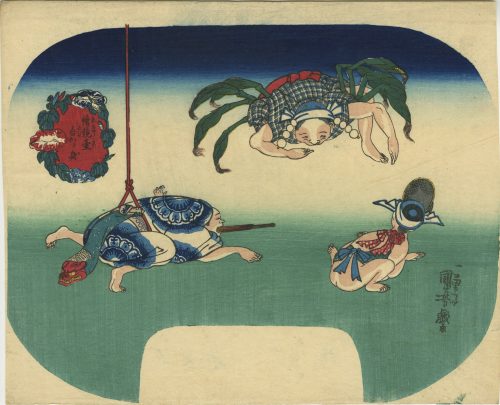 Artist: Utagawa Kuniyoshi [歌川 國芳] (Japanese, 1798 – 1861). Publisher: Ibaya Senzaburō [伊場屋仙三郎] (Japanese, c. 1815 – 1869), no publisher's seal on this print. Another title of this image provided by Sebastian Izzard is Acrobats becoming animals. The series Brother Pictures for Comparison [絵鏡台合かゝ身] (e-kyôdai awase kagami) can be found at Kuniyoshi Project: "This series consists of pairs of fan prints, with one print of each pair being a silhouette of the other. The series is not listed in Kuniyoshi by Basil William Robinson (Victoria and Albert Museum, London, 1961)". The series is attributed to c. 1840. Signed: Ichiyosai Kuniyoshi ga. Size: Size: Uchiwa-e (untrimmed fan print) 227 x 299 mm.
Artist: Utagawa Kuniyoshi [歌川 國芳] (Japanese, 1798 – 1861). Publisher: Ibaya Senzaburō [伊場屋仙三郎] (Japanese, c. 1815 – 1869), no publisher's seal on this print. Another title of this image provided by Sebastian Izzard is Acrobats becoming animals. The series Brother Pictures for Comparison [絵鏡台合かゝ身] (e-kyôdai awase kagami) can be found at Kuniyoshi Project: "This series consists of pairs of fan prints, with one print of each pair being a silhouette of the other. The series is not listed in Kuniyoshi by Basil William Robinson (Victoria and Albert Museum, London, 1961)". The series is attributed to c. 1840. Signed: Ichiyosai Kuniyoshi ga. Size: Size: Uchiwa-e (untrimmed fan print) 227 x 299 mm. -
 Artist: Utagawa Sadahide [歌川 貞秀], a.k.a. Gountei Sadahide [五雲亭 貞秀] (1807 – c. 1878/9). Signed: Gountei Sadahide ga [五雲亭貞秀画] Pubisher: Ibaya Senzaburō [伊場屋仙三郎] (Japanese, 1815 – 1869) Date-aratame seal: Bunsei 13 / Tenpō 1 (1830). Ref: Ritsumeikan University # Z0172-587. Title: Yukari no Edo-zakura [ゆかりの江戸桜], often translated into English as 'The Flower of Edo', is a one-act kabuki play Sukeroku, written by Tsuuchi Han'emon (fl. 1701 – 1743) under the supervision of Tsuuchi Jihei II (1673 – 1760 ) at the beginning of the 18th century. From the beginning of the 19th century, the play was performed in the style of katōbushi. 助六所縁江戸桜(すけろくゆかりのえどざくら。「助六」– one of the main melodies in katōbushi (河東節) type of jōruri [浄瑠璃]. For a detailed explanation in Japanese, see also HERE). Plot: In search of the stolen Minamoto clan's precious sword called Tomokirimaru, Soga Gorō (historical Soga Tokimune [曾我時致], 1174 – 1193) came to a Yoshiwara brothel under the disguise of a debaucher named Hanagawado Sukeroku. His elder brother, Soga Jūrō (historical Soga Sukenari [曾我祐成], 1172 – 1193) ), has assumed the guise of a wine vendor Shinbei. The character who had the Tomokirimaru sword was Ikyū (historical Iga no Heinaizaemon, a Tiara clan's ally), see SVJP-0164.2014. A series of three prints is dedicated to a katōbushi performance of the Soga-themed plays.
Artist: Utagawa Sadahide [歌川 貞秀], a.k.a. Gountei Sadahide [五雲亭 貞秀] (1807 – c. 1878/9). Signed: Gountei Sadahide ga [五雲亭貞秀画] Pubisher: Ibaya Senzaburō [伊場屋仙三郎] (Japanese, 1815 – 1869) Date-aratame seal: Bunsei 13 / Tenpō 1 (1830). Ref: Ritsumeikan University # Z0172-587. Title: Yukari no Edo-zakura [ゆかりの江戸桜], often translated into English as 'The Flower of Edo', is a one-act kabuki play Sukeroku, written by Tsuuchi Han'emon (fl. 1701 – 1743) under the supervision of Tsuuchi Jihei II (1673 – 1760 ) at the beginning of the 18th century. From the beginning of the 19th century, the play was performed in the style of katōbushi. 助六所縁江戸桜(すけろくゆかりのえどざくら。「助六」– one of the main melodies in katōbushi (河東節) type of jōruri [浄瑠璃]. For a detailed explanation in Japanese, see also HERE). Plot: In search of the stolen Minamoto clan's precious sword called Tomokirimaru, Soga Gorō (historical Soga Tokimune [曾我時致], 1174 – 1193) came to a Yoshiwara brothel under the disguise of a debaucher named Hanagawado Sukeroku. His elder brother, Soga Jūrō (historical Soga Sukenari [曾我祐成], 1172 – 1193) ), has assumed the guise of a wine vendor Shinbei. The character who had the Tomokirimaru sword was Ikyū (historical Iga no Heinaizaemon, a Tiara clan's ally), see SVJP-0164.2014. A series of three prints is dedicated to a katōbushi performance of the Soga-themed plays.
They all have a background of hail patterns (Arare-ko-mon) [霰小紋], similar to Kunisada’s Iwai Kumesaburō II as An no Heibei [SVJP-0304.2019], see below.Yukari no Edo-zakura The tatami night robe of Iwao Tangled Hair and the Evening Braided Hat 
-
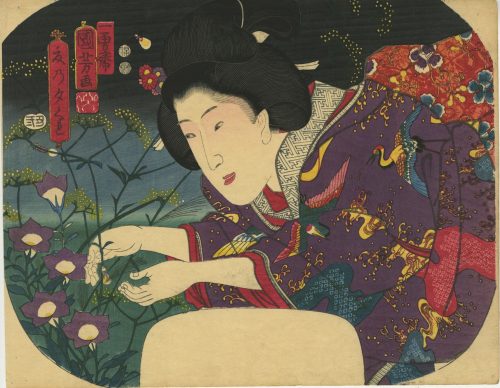 Artist: Utagawa Kuniyoshi [歌川 國芳] (Japanese, 1798 – 1861). Publisher: Enshuya Matabei [遠州屋又兵衛] (Japanese, fl. c. 178 – 1881) – no seal, ref: Kunisada Project. Title: A Summer Evening [夏乃夕暮] (Natsu no Yūgure). A young woman in purple kimono decorated with cranes and waves catching a firefly among yellow and purple flowers. Signed: Ichiyosai Kuniyoshi ga [一勇斎 国芳 画] in a red cartouche and sealed with paulownia (kiri mon). Date seal and double nanushi censor seals: Fuku & Muramatsu, 1853 (Kaei 6, 2nd month). No publisher's seal. Size: Uchiwa-e (untrimmed fan print) 228 x 296 mm. The yellow flower is probably Patrinia scabiosifolia (ominaeshi) [女郎花]. The purple flower seems to be Platycodon grandiflorus or Balloon Flower (kikyō) [桔梗]. Besides, there are visible panicles of Miscanthus sinensis, or Japanese pampas grass (susuki) [薄]. These three are part of the Seven Grasses of Autumn (aki no nanakusa) [秋の七草].
Artist: Utagawa Kuniyoshi [歌川 國芳] (Japanese, 1798 – 1861). Publisher: Enshuya Matabei [遠州屋又兵衛] (Japanese, fl. c. 178 – 1881) – no seal, ref: Kunisada Project. Title: A Summer Evening [夏乃夕暮] (Natsu no Yūgure). A young woman in purple kimono decorated with cranes and waves catching a firefly among yellow and purple flowers. Signed: Ichiyosai Kuniyoshi ga [一勇斎 国芳 画] in a red cartouche and sealed with paulownia (kiri mon). Date seal and double nanushi censor seals: Fuku & Muramatsu, 1853 (Kaei 6, 2nd month). No publisher's seal. Size: Uchiwa-e (untrimmed fan print) 228 x 296 mm. The yellow flower is probably Patrinia scabiosifolia (ominaeshi) [女郎花]. The purple flower seems to be Platycodon grandiflorus or Balloon Flower (kikyō) [桔梗]. Besides, there are visible panicles of Miscanthus sinensis, or Japanese pampas grass (susuki) [薄]. These three are part of the Seven Grasses of Autumn (aki no nanakusa) [秋の七草]. -
 Utagawa Kunisada [歌川 国貞]; a.k.a. Utagawa Toyokuni III [三代歌川豊国] (Japanese, 1786 – 1865). Signed: Toyokuni ga [豊国 画] in a red toshidama cartouche. Publisher: Mikawaya Heiroku [三川屋平六] (Japanese, fl. c. 1848 – 1856); seal: Mihei [三平] (Marks 11-016 | 325a) Block carver: Yokokawa Takejirō [横川竹二郎] (Japanese, fl. 1845 – 1863), seal: 彫竹 – Hori Take. Date seal and aratame censor seal: [辰正] Ansei 3, 1st month (1856). Inscriptions: Right cartouche: Three good fortunes of the present day [当世三福対] (Tosei sambuku tsui) Center cartouche: Ubuge no Kintaro [産毛の金太郎] (うぶげのきんたろう) According to Horst Graebner, the play is Tomigaoka koi no Yamabiraki (or Tomioka Koi no Yamabiraki [富岡戀山開], according to kabuki21.com, common title Ninin Shinbē [二人新兵衛]); Kintarō might be Nakamura Fukusuke I [中村福助], the female role might be Mikuni Kojorō [三国小女郎] (or Mikuni no Kojorō). Nakamura Shikan IV [中村芝翫] (Japanese, 1831 – 1899); other names: Nakamura Fukusuke I, Nakamura Masanosuke I, Nakamura Komasaburō, Nakamura Tamatarō I.
Utagawa Kunisada [歌川 国貞]; a.k.a. Utagawa Toyokuni III [三代歌川豊国] (Japanese, 1786 – 1865). Signed: Toyokuni ga [豊国 画] in a red toshidama cartouche. Publisher: Mikawaya Heiroku [三川屋平六] (Japanese, fl. c. 1848 – 1856); seal: Mihei [三平] (Marks 11-016 | 325a) Block carver: Yokokawa Takejirō [横川竹二郎] (Japanese, fl. 1845 – 1863), seal: 彫竹 – Hori Take. Date seal and aratame censor seal: [辰正] Ansei 3, 1st month (1856). Inscriptions: Right cartouche: Three good fortunes of the present day [当世三福対] (Tosei sambuku tsui) Center cartouche: Ubuge no Kintaro [産毛の金太郎] (うぶげのきんたろう) According to Horst Graebner, the play is Tomigaoka koi no Yamabiraki (or Tomioka Koi no Yamabiraki [富岡戀山開], according to kabuki21.com, common title Ninin Shinbē [二人新兵衛]); Kintarō might be Nakamura Fukusuke I [中村福助], the female role might be Mikuni Kojorō [三国小女郎] (or Mikuni no Kojorō). Nakamura Shikan IV [中村芝翫] (Japanese, 1831 – 1899); other names: Nakamura Fukusuke I, Nakamura Masanosuke I, Nakamura Komasaburō, Nakamura Tamatarō I. -
 Artist: Utagawa Kunisada [歌川 国貞]; a.k.a. Utagawa Toyokuni III [三代歌川豊国] (Japanese, 1786 – 1865). Signed: Toyokuni ga [豊国 画] in a red toshidama cartouche. Publisher: Ibaya Senzaburō [伊場屋仙三郎] (Japanese, fl. C. 1845 – 1847), seal: San [三] (Marks 11-001 | 127c). Block carver: Matsushima Fusajirō [松嶋房次郎] (Japanese, fl. 1843 – 1850); seal [彫工房] – Hori kō Fusa. Double nanushi censor seal: Kunigasa & Watanabe (1849-50). Actor: Ichikawa Danjūrō VII [市川団十郎] (Japanese, 1791 – 1859); other names: Ichikawa Ebizō V [市川海老蔵], Ichikawa Hakuen II, Ichikawa Shinnosuke I. Play: Yukari no Hana Iro mo Yoshiwara [紫花色吉原], performed at the Kawarazaki Theater (Edo) from the 5th day of the 5th lunar month of Kaei 3 (1850) (see Kabuki Playbill at MFA (Boston) № 11.27996).
Artist: Utagawa Kunisada [歌川 国貞]; a.k.a. Utagawa Toyokuni III [三代歌川豊国] (Japanese, 1786 – 1865). Signed: Toyokuni ga [豊国 画] in a red toshidama cartouche. Publisher: Ibaya Senzaburō [伊場屋仙三郎] (Japanese, fl. C. 1845 – 1847), seal: San [三] (Marks 11-001 | 127c). Block carver: Matsushima Fusajirō [松嶋房次郎] (Japanese, fl. 1843 – 1850); seal [彫工房] – Hori kō Fusa. Double nanushi censor seal: Kunigasa & Watanabe (1849-50). Actor: Ichikawa Danjūrō VII [市川団十郎] (Japanese, 1791 – 1859); other names: Ichikawa Ebizō V [市川海老蔵], Ichikawa Hakuen II, Ichikawa Shinnosuke I. Play: Yukari no Hana Iro mo Yoshiwara [紫花色吉原], performed at the Kawarazaki Theater (Edo) from the 5th day of the 5th lunar month of Kaei 3 (1850) (see Kabuki Playbill at MFA (Boston) № 11.27996). Sano Jirōzaemon [佐野次郎左衛門] – provincial commoner who killed a famous Yoshiwara courtesan named ManjiyaYatsuhashi [万字屋 八ツ橋] (on the second sheet of the pair):
Sano Jirōzaemon [佐野次郎左衛門] – provincial commoner who killed a famous Yoshiwara courtesan named ManjiyaYatsuhashi [万字屋 八ツ橋] (on the second sheet of the pair):
Another Kunisada's print with the same characters in the same play and same performance can be seen at MFA (Boston) № 11.40190.
SVJP-0298.2019: Ichikawa Ebizō V as Sano Jirōzaemon.

SVJP-0297.2019: Iwai Kumesaburō III as Manjiya Yatsuhashi
 One more example can be seen at the two upper images in Waseda University Cultural Resources Database, № 006-2707:
One more example can be seen at the two upper images in Waseda University Cultural Resources Database, № 006-2707:

-
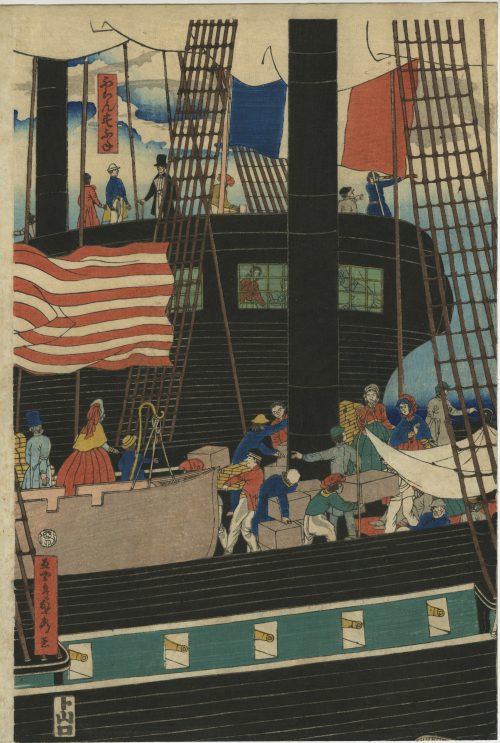 Utagawa Sadahide, a.k.a. Gountei Sadahide (Japanese, 1807 – c. 1878–1879), 五雲亭 貞秀, 歌川 貞秀, Yamaguchiya Tōbei, Yokohama kōeki seiyōjin nimotsu unsō no zu - Western traders loading cargo in Yokohama - 横浜交易西洋人荷物運送之圖, 1861, Woodblock print (nishiki-e); ink and color on paper, Horizontal Ōban Pentaptych: 5 x (37 x 25.5 cm), Alternative title: Picture of Western Traders at Yokohama Transporting Merchandise (Cat. Reisonée: Yokohama ukiyo-e, Yurindo, 1979: №50). Japanese pentaptych print shows an American ship in the harbor at Yokohama, Japan; small boats ferry cargo which is being carried up a gangplank contributing to the bustle of activity on the main deck. April, 1861. SOLD
Utagawa Sadahide, a.k.a. Gountei Sadahide (Japanese, 1807 – c. 1878–1879), 五雲亭 貞秀, 歌川 貞秀, Yamaguchiya Tōbei, Yokohama kōeki seiyōjin nimotsu unsō no zu - Western traders loading cargo in Yokohama - 横浜交易西洋人荷物運送之圖, 1861, Woodblock print (nishiki-e); ink and color on paper, Horizontal Ōban Pentaptych: 5 x (37 x 25.5 cm), Alternative title: Picture of Western Traders at Yokohama Transporting Merchandise (Cat. Reisonée: Yokohama ukiyo-e, Yurindo, 1979: №50). Japanese pentaptych print shows an American ship in the harbor at Yokohama, Japan; small boats ferry cargo which is being carried up a gangplank contributing to the bustle of activity on the main deck. April, 1861. SOLD





